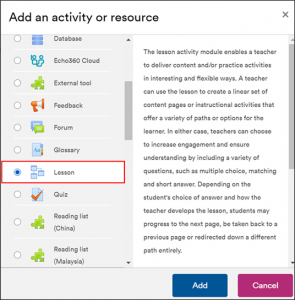
August 14, 2020, by Helen Whitehead
A Summer of Moodle #7: Building branching scenarios in Moodle
Did you know you can build branching scenarios on Moodle?
 Using the Lesson Activity, you can build interactive branching activities in which you can present students with a scenario, the ability to make choices, and the consequences of their decisions.
Using the Lesson Activity, you can build interactive branching activities in which you can present students with a scenario, the ability to make choices, and the consequences of their decisions.
Before you start building your branching scenario in Moodle, here are some things you should consider:
- Plan your branching scenarios. Think of what you want your students to learn and why it is important that they learn this.
- Speak to a colleague. Asking a colleague for their advice on a branching scenario could prove useful as they might think of choices and consequences that you don’t.
- Think about the best case and worst-case scenarios. Try and think of both the best case and worst-case scenarios and include them so students know what to aim for or avoid.
- Map it out. Branching scenarios can get complicated and hard to track where each choice leads. Map it out on paper or on cards and this will help you when it comes to building the scenario.
- Think about your student(s). Think about what level students are at. What should they know at this level? You don’t want your branching scenario to be too easy or based on information they have no knowledge of.
- Make it realistic. Try and make the scenario match what would happen in real life so make the choices plausible, give the characters names and maybe use images or videos to help illustrate.
- Give opportunities for students to correct mistakes. In real life people make wrong decisions but have opportunities to fix them so why should this not be the case in your branching scenario.
- Don’t overcomplicate things. Branching scenarios can get complicated very quickly. Try limiting the number of choices to 3 or 4. This will make it easier for you to keep track of where each branch goes which will also make it easier to build.
A useful model for building branching scenarios
One way you could approach designing a branching scenario is Tom Kuhlman’s (2009) 3 C Model [external link, opens in new window]. Here you present learners with a Challenge and then offer them a Choice what they want to do next. Once they have made their choice, they are presented with the Consequence of that decision. You can then choose to end the scenario there or to present the learner with another Challenge and continue with the branching scenario.

However, it’s important that you end each branch of your branching scenario with some feedback. This feedback should show where a student has gone right and/ or wrong. It should also show what they should have done so they would know what to do next time.
Further help and information
When it comes building your branching scenario on Moodle, these pages on how to create a lesson [UoN Workspace link] and how to add a page to lesson [UoN Workspace link] will come in handy as they will take you step-by-step through the process of building a lesson on Moodle.
If you want to experience some branching scenarios in Moodle yourself, there are a number of examples on the Moodle module FOODLE – Front of House Moodle (LRLR) (UNUK) [Link to UoN Moodle: login required] onto which you can self-enrol. These examples are good as they allow you to fix your mistakes and guide you in the right direction.
As an alternative to using Lessons in Moodle, you could create your branching scenario using decision trees in Xerte Toolkits, or in a PowerPoint, both of which can be added to your Moodle module.
Claire Storr
No comments yet, fill out a comment to be the first

Leave a Reply